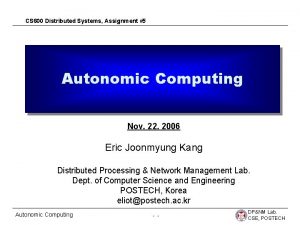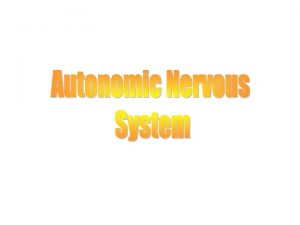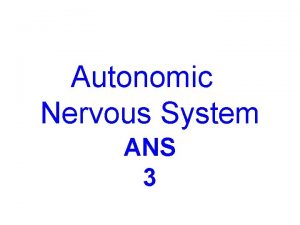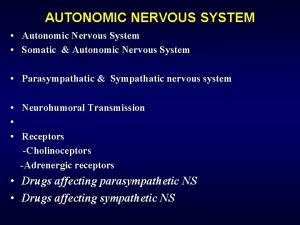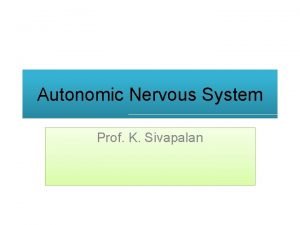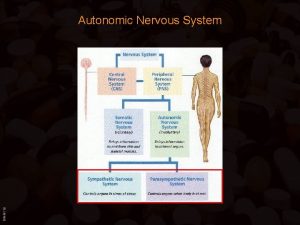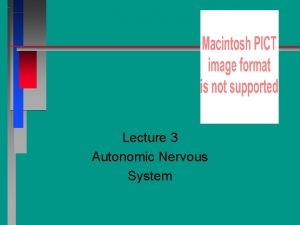Autonomic Network Management as a solution to Management














- Slides: 14

Autonomic Network Management as a solution to Management Complexity By Ehimare Philip Imobhio, By Sravya Kalapala and Prasanth Gutti

Introduction Communication Networks has greatly increased in size and complexity recently. Also, end users and service level requirements have become drastically more vast. This has made managing largescale systems more difficult and it constantly on the increase. This project aim is to bring a lasting solution to this management complexity by managing current and future communication networks. We therefore are introducing Autonomic Network

This system has a major goal and this is to adapt the network’s services and resources in parallel to environmental changes and user requirements. We will also be introducing the Policy Network Management Architecture which enable the system to effectively automate low-level configurations in compliance with high level business goals therefore, the increasing management complexity can be

Factors Deciding Autonomic System Performance • • • Self Locating Self Healing Self Protecting Self Configuring Self Optimizing Self and Context Awareness

Platform Requirements • • • Network-wide Prospective Applications Involvement Cognitive Support Sensory Support Human Supervision Information Interoperability

Problem Definition: Networks is increasingly getting very Complex • • • The Complexity of system design and management is daily on an increase – Stovepipe systems: best-of-breed functionality but very difficult to integrate so they share functionalities and resources – Increased technology can be overwhelming to users and administrators • Different devices have different programming models and interaction models • Different management tasks and integration types require different skill levels The business complexity is equally on the increase – Human demands is of a pervasive nature – A lot of different businesses Lose Money if they can not react fast enough to this demands – Varieties of threats, problems, and non-optimized behavior keeps increasing Behavioral complexity is also increasing – Everything is now interconnected, therefore requiring different

Definition and Goal of Autonomic Network Management AUTONOMIC NETWORK MANAGEMENT • Simplify network management process by automating and distributing the decision making processes involved in optimizing network operation. • Enable expensive human attention to focus more on business logic and less on low level device configuration processes. GOALS • Minimize Operator Intervention. • Reduce dependencies on Human Resources to the barest minimum. • Reduces Errors. • Supports agile businesses.

Autonomic Management Architecture

Focale Autonomic Management Stands for Foundation Observation Comparison Action Learn r. Eason – It is based on the observation that business objectives, customer requirements, and environmental context all change dynamically – Two control loop • Inner control-loops They make more detailed adjustments of functionality within a specific context. • Outer control loops They perform large-scale adjustments by reacting to context changes. – It is unreasonable to assume that a single entity can maintain all the information required to realize the FOCALE control loops for large scale networks containing large numbers of heterogeneous devices – FOCALE must be a distributed architecture, to the degree that even individual network devices may incorporate autonomic management software, implementing the maintenance and adjustment control loops

Types of Inner and Outer Loops • There are three major types of Inner and Outer Loops: o Reactive control loops o Deliberative control loops o Reflective control loops • • • Reactive Control Loops: This path is taken when adapting to a previously analyzed context change. Here, a previously inferred behavioral change can be executed without complex reasoning. Deliberative Control Loops: This is used when context changes that are not properly understood take place. Reflective Control Loops: This provides an avenue to better understand how context changes affect the goals of AEs. It is also important to note that these types of loops are dependent on cognitive phycology and human decision making history.

Communication Types Between Autonomic Elements • Cluster Management: A cluster can be defined as the group of Autonomic Elements that have the same parent Autonomic Element. It is of great importance that we determine which Autonomic Element in each cluster will play the role of the parent. Hence Cluster Management. • Context Dissemination: Context dissemination is an integral part of any autonomic management system, ultimately used to model the static state of its managed entities, which also then allows the system to reshape to changes whenever effected. • Policy Interaction: Although administrators of an autonomic management systems are not directly involved in configuring management algorithms and managed entities, they do control the entire process by adding rules to the rules repository. • Autonomic Element Collaboration: Previously, we talked about how the interchange of policies and context and the organization of Autonomic Elements themselves can be handled. Here we will be focusing on another very important communication area in a distributed management environment and this is the behavioral orchestration between Autonomic Elements. • Management Algorithm: These management algorithms oversee configuration of the managed entities, to make sure their state in turn reflect a desired

Conclusion • In this project, we briefly discussed the current state of Management evolution in Computer Networks, and some of the challenges with the rapid expansion of the internet resources. We discussed the solution based on an Autonomic Network Management Initiative and the subsequent works on creating Autonomic Network Management platforms that are similar to these ideas. An architecture is presented, which will provides a specific set of functionalities to facilitate the creation of management containers, which are similar to a high-level goal.

References • • Agoulmine, N. and Balasubramaniam, Sasitharan and Botvich, Dmitri and Strassner, John and Lehtihet, E. and Donnelly, William (2006). Challenges for Autonomic Network Management. In proceedings of 1 st IEEE International Workshop on Modelling Autonomic Communications Environments (MACE). Schaumburg, IL 60010, USA. A. Louca, A. Mauthe, D. Hutchinson (2010). Autonomic Network Management for Next Generation Networks. Computing Department Info. Lab 21, Lancaster University, Lancaster, LA 1 4 WA. Sven van der Meer, Willie Donnelly, John Strassner, Brendan Jennings, Mícheál Ó Foghlú. Emerging Principles of Autonomic Network Management. (2004) John C. Strassner 1 , Nazim Agoulmine 2 , Elyes Lehtihet 2, 3 (2006). FOCALE – A Novel Autonomic Networking Architecture. In proceedings of Networks and Multimedia Systems Group – University of Evry Val d’Essonne Evry Courcouronnes, France.

QUESTIONS ?
 Autonomic network management
Autonomic network management Nervous system def
Nervous system def Choque medular
Choque medular Autonomic nervous system muscles
Autonomic nervous system muscles Autonomic nervous system consists of
Autonomic nervous system consists of Ans
Ans Visceral reflex arc in order
Visceral reflex arc in order Terminal ganglia
Terminal ganglia Ganglion on spine
Ganglion on spine An architectural blueprint for autonomic computing
An architectural blueprint for autonomic computing Autonomic drugs
Autonomic drugs Autonomic nervous system
Autonomic nervous system The autonomic nervous system controls
The autonomic nervous system controls Autonomic drugs
Autonomic drugs The vision of autonomic computing
The vision of autonomic computing









